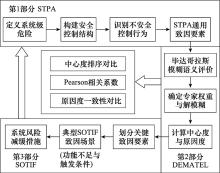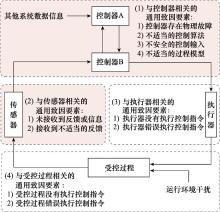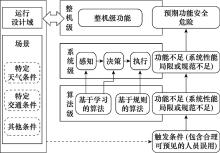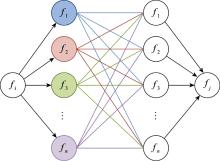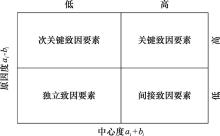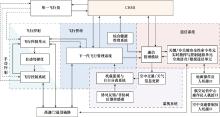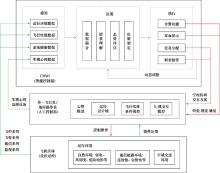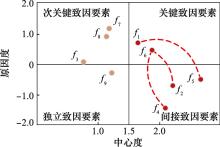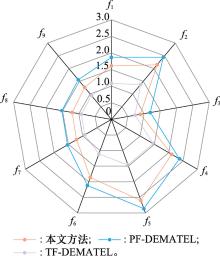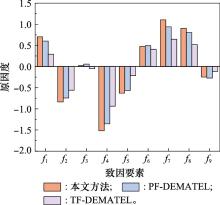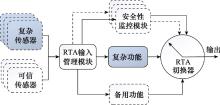Systems Engineering and Electronics ›› 2024, Vol. 46 ›› Issue (6): 2023-2033.doi: 10.12305/j.issn.1001-506X.2024.06.20
• Systems Engineering • Previous Articles
Causal factor analysis of AI-based avionics system based on improved STPA-DEMATEL
Jiachen LIU1,2, Lei DONG1,3,*, Xi CHEN1,3, Boyao LIANG1,2, Peng WANG1,3
- 1. Key Laboratory of Civil Aircraft Airworthiness Technology, Civil Aviation University of China, Tianjin 300300, China
2. College of Safety Science and Engineering, Civil Aviation University of China, Tianjin 300300, China
3. Department of Science and Technology, Civil Aviation University of China, Tianjin 300300, China
-
Received:2023-01-03Online:2024-05-25Published:2024-06-04 -
Contact:Lei DONG
CLC Number:
Cite this article
Jiachen LIU, Lei DONG, Xi CHEN, Boyao LIANG, Peng WANG. Causal factor analysis of AI-based avionics system based on improved STPA-DEMATEL[J]. Systems Engineering and Electronics, 2024, 46(6): 2023-2033.
share this article
Table 2
Air-ground collaborative interaction program of SPO"
| 机组控制能力 | 飞行驾驶条件 | |
| 标称驾驶 | 非标称驾驶 | |
| 健康 | (1) SPO飞行员控制飞行, 智能航电系统辅助 (2) 航空运营中心操作员在地面站系统辅助下监控并支持多架SPO飞机 | (1) SPO飞行员控制飞行, 智能航电系统辅助 (2) 地面操作员在地面站系统辅助下为SPO飞机提供“一对一”的飞行支持 |
| 失能 | (1) 在地面站系统辅助下, 地面操作员承担SPO飞行员职责, 全权操控SPO驾驶舱机载系统, 控制飞机安全着陆 (2) 智能航电系统执行来自地面操作员的指令 | (1) 在地面站系统辅助和多名支持人员的辅助下, 一名地面操作员承担SPO飞行员职责, 控制飞机安全着陆(除非通信网络中断) (2) 智能航电系统执行来自地面操作员的指令 |
Table 3
UCAs identification of AI-based avionics system"
| 类型 | 未提供控制行为 | 提供错误控制行为 | 提供错误时序的控制行为 |
| 不安全控制行为描述 | UCAs-1当控制人员的心智模型发生变化时, 智能航电系统未调整空地协同交互方案 | UCAs-2当控制人员的心智模型发生变化时, 智能航电系统调整了错误的空地协同交互方案 UCAs-3当控制人员的心智模型未发生变化时, 智能航电系统调整了不必要的空地协同交互方案 | UCAs-4当控制人员的心智模型发生变化时, 智能航电系统未能及时调整空地协同交互方案 |
| 可能导致的危险 | UCAs-1:H1-2/3, H2-2/3 | UCAs-2:H1-3/4, H2-3/4 UCAs-3:H1-2, H2-2 | UCAs-4:H1-1/2, H2-1/2 |
| 可能导致的事故 | UCAs-1:A-1, A-2 | UCAs-2:A-1, A-2, A-3 UCAs-3:A-1 | UCAs-4:A-1, A-2 |
Table 4
Causal factors extraction of AI-based avionics system"
| 编号 | 致因要素描述 | STPA通用致因要素 | 参考文献 |
| f1 | 数据集不均衡、规模较小或标注质量较差 | 不适当的控制算法 | [ |
| f2 | 算法目标函数过拟合或欠拟合 | 不适当的控制算法 | [ |
| f3 | 算法对学习框架和软硬件平台适应性较差 | 不适当的控制算法 | [ |
| f4 | 算法容易受到对抗样本的欺骗, 鲁棒性较差 | 不适当的过程模型 | [ |
| f5 | 干扰数据、数据集分布迁移及野值数据 | 不适当的过程模型 | [ |
| f6 | 传感器性能退化导致数据收集受到干扰 | 接收到不适当的反馈 | [ |
| f7 | 驾驶舱环境质量较差(振动、烟雾、强光等) | 接收到不适当的反馈 | [ |
| f8 | 生理心理监测设备佩戴不规范 | 未接收到反馈或信息 | [ |
| f9 | 系统控制指令与飞行员习惯不一致(人员误用) | 不安全的控制输入 | [ |
Table 5
Fuzzy-relation matrix"
| 编号 | f1 | f2 | f3 | f4 | f5 | f6 | f7 | f8 | f9 |
| f1 | (0.100, 0.900) | (0.900, 0.100) | (0.338, 0.682) | (0.750, 0.200) | (0.422, 0.566) | (0.535, 0.493) | (0.100, 0.900) | (0.100, 0.900) | (0.281, 0.706) |
| f2 | (0.100, 0.900) | (0.100, 0.900) | (0.311, 0.716) | (0.900, 0.100) | (0.350, 0.600) | (0.100, 0.900) | (0.100, 0.900) | (0.100, 0.900) | (0.100, 0.900) |
| f3 | (0.100, 0.900) | (0.295, 0.686) | (0.100, 0.900) | (0.422, 0.566) | (0.100, 0.900) | (0.100, 0.900) | (0.100, 0.900) | (0.100, 0.900) | (0.500, 0.450) |
| f4 | (0.100, 0.900) | (0.422, 0.566) | (0.100, 0.900) | (0.100, 0.900) | (0.100, 0.900) | (0.100, 0.900) | (0.100, 0.900) | (0.100, 0.900) | (0.350, 0.600) |
| f5 | (0.500, 0.450) | (0.753, 0.229) | (0.422, 0.566) | (0.750, 0.200) | (0.100, 0.900) | (0.100, 0.900) | (0.100, 0.900) | (0.100, 0.900) | (0.100, 0.900) |
| f6 | (0.350, 0.600) | (0.676, 0.278) | (0.350, 0.600) | (0.500, 0.450) | (0.750, 0.200) | (0.100, 0.900) | (0.100, 0.900) | (0.100, 0.900) | (0.500, 0.450) |
| f7 | (0.100, 0.900) | (0.350, 0.600) | (0.338, 0.682) | (0.650, 0.310) | (0.900, 0.100) | (0.500, 0.450) | (0.100, 0.900) | (0.100, 0.900) | (0.500, 0.450) |
| f8 | (0.350, 0.600) | (0.647, 0.310) | (0.100, 0.900) | (0.629, 0.325) | (0.857, 0.132) | (0.419, 0.535) | (0.100, 0.900) | (0.100, 0.900) | (0.100, 0.900) |
| f9 | (0.338, 0.682) | (0.238, 0.765) | (0.100, 0.900) | (0.350, 0.600) | (0.459, 0.495) | (0.238, 0.765) | (0.100, 0.900) | (0.350, 0.600) | (0.100, 0.900) |
Table 6
Total-relation matrix"
| 编号 | f1 | f2 | f3 | f4 | f5 | f6 | f7 | f8 | f9 |
| f1 | 0.109 | 0.173 | 0.089 | 0.210 | 0.206 | 0.104 | 0.065 | 0.075 | 0.125 |
| f2 | 0.031 | 0.179 | 0.014 | 0.178 | 0.168 | 0.061 | -0.032 | -0.017 | 0.074 |
| f3 | 0.005 | 0.146 | 0.003 | 0.186 | 0.172 | 0.037 | -0.061 | -0.045 | 0.020 |
| f4 | -0.019 | 0.124 | -0.022 | 0.201 | 0.158 | 0.013 | -0.093 | -0.076 | 0.007 |
| f5 | 0.051 | 0.164 | 0.055 | 0.201 | 0.216 | 0.108 | 0.031 | 0.043 | 0.117 |
| f6 | 0.092 | 0.180 | 0.089 | 0.222 | 0.187 | 0.136 | 0.072 | 0.081 | 0.112 |
| f7 | 0.111 | 0.198 | 0.091 | 0.215 | 0.183 | 0.104 | 0.069 | 0.079 | 0.111 |
| f8 | 0.074 | 0.173 | 0.092 | 0.210 | 0.176 | 0.094 | 0.048 | 0.059 | 0.128 |
| f9 | 0.001 | 0.153 | 0.014 | 0.188 | 0.147 | 0.037 | -0.043 | -0.050 | 0.059 |
Table 7
Centrality and causality of causal factors"
| 编号 | 影响度 | 被影响度 | 中心度 | 原因度 |
| f1 | 1.157 | 0.454 | 1.611 | 0.703 |
| f2 | 0.656 | 1.491 | 2.147 | -0.835 |
| f3 | 0.463 | 0.424 | 0.887 | 0.039 |
| f4 | 0.293 | 1.810 | 2.103 | -1.517 |
| f5 | 0.985 | 1.613 | 2.598 | -0.628 |
| f6 | 1.170 | 0.693 | 1.863 | 0.477 |
| f7 | 1.161 | 0.056 | 1.217 | 1.105 |
| f8 | 1.054 | 0.149 | 1.203 | 0.905 |
| f9 | 0.505 | 0.754 | 1.259 | -0.249 |
| 1 | 董磊, 刘嘉琛, 陈曦, 等. 面向适航符合性的智能航电系统认证研究进展[J]. 航空工程进展, 2023, 14 (3): 26- 40. |
| DONG L , LIU J C , CHEN X , et al. Research progress of AI-based avionics system certification for airworthiness compliance[J]. Advances in Aeronautical Science and Engineering, 2023, 14 (3): 26- 40. | |
| 2 | 卢新来, 杜子亮, 许赟. 航空人工智能概念与应用发展综述[J]. 航空学报, 2021, 42 (4): 251- 64. |
| LU X L , DU Z L , XU Y . Review on basic concept and applications for artificial intelligence in aviation[J]. Acta Aeronautica et Astronautica Sinica, 2021, 42 (4): 251- 264. | |
| 3 | GABREAU C, PESQUET-POPESCU B, KAAKAI F, et al. AI for future skies: on-going standardization activities to build the next certification/approval framework for airborne and ground aeronautical products[C]//Proc. of the International Joint Conference on Artificial Intelligence, 2021. |
| 4 | SCHWEIGER A, ANNIGHOEFER B, REICH M, et al. Classification for avionics capabilities enabled by artificial intelligence[C]//Proc. of the IEEE/AIAA 40th Digital Avionics Systems Conference, 2021. |
| 5 | COFER D. Unintended behavior in learning-enabled systems: detecting the unknown unknowns[C]//Proc. of the IEEE/AIAA 40th Digital Avionics Systems Conference, 2021. |
| 6 | 李超. 复杂装备事故非线性耦合特征WPD-MF分析[J]. 中国安全科学学报, 2019, 29 (12): 97- 102. |
| LI C . Research on non-linear coupling characteristics of complex materiel accident based on WPD-MF human-computer interaction safety analysis of airborne system from perspective of emergence[J]. China Safety Science Journal, 2019, 29 (12): 97- 102. | |
| 7 | 赵长啸, 李浩, 张伟, 等. 涌现性视角下机载系统人机交互安全性分析[J]. 中国安全科学学报, 2022, 32 (11): 113- 120. |
| ZHAO C X , LI H , ZHANG W , et al. Human-computer interaction safety analysis of airborne system from perspective of emergence[J]. China Safety Science Journal, 2022, 32 (11): 113- 120. | |
| 8 | HOBBS K L, HEINER B K, BUSSE L, et al. Systems theoretic process analysis of a run time assured neural network control system[C]//Proc. of the AIAA SciTech Forum, 2023: 2664. |
| 9 | UTNE I B , ROKSETH B , VINNEM J E , et al. Towards supervisory risk control of autonomous ships[J]. Reliability Engineering & System Safety, 2020, 196, 106757. |
| 10 |
ZHANG S J , TANG T , LIU J T . A hazard analysis approach for the SOTIF in intelligent railway driving assistance systems using STPA and complex network[J]. Applied Sciences, 2021, 11 (16): 7714.
doi: 10.3390/app11167714 |
| 11 | 谈东奎, 胡港君, 朱波, 等. 考虑预期功能安全的智能汽车自动紧急制动系统[J]. 汽车工程, 2022, 44 (6): 799- 808. |
| TAN D K , HU G J , ZHU B , et al. Intelligent vehicle autonomous emergency braking system considering safety of the intended functionality[J]. Automotive Engineering, 2022, 44 (6): 799- 808. | |
| 12 | SI S L , YOU X Y , LIU H C , et al. DEMATEL technique: a systematic review of the state-of-the-art literature on methodologies and applications[J]. Mathematical Problems in Engineering, 2018, 2018, 3696457. |
| 13 | 孙永河, 黄子航, 李阳. DEMATEL复杂因素分析算法最新进展综述[J]. 计算机科学与探索, 2022, 16 (3): 541- 551. |
| SUN Y H , HUANG Z H , LI Y . Review of state of the art on DEMATEL algorithms for complex factor analysis[J]. Journal of Frontiers of Computer Science and Technology, 2022, 16 (3): 541- 551. | |
| 14 | 钟德明, 宫浩原, 孙睿. 一种准确识别损失场景的STPA[J]. 北京航空航天大学学报, 2023, 49 (2): 311- 323. |
| ZHONG D M , GONG H Y , SUN R . An STPA for accurately identifying loss scenarios[J]. Journal of Beijing University of Aeronautics and Astronautics, 2023, 49 (2): 311- 323. | |
| 15 | ABDULAZIM A, ELBAHAEY M, MOHAMED A. Putting safety of intended functionality SOTIF into practice[R]. Pittsburgh: Society of Automotive Engineers, 2021: 3-6. |
| 16 | European Union Aviation Safety Agency. Concepts of design assurance for neural networks(CoDANN)[R]. Cologne: European Union Avition Safety Agency, 2020: 28-62. |
| 17 | Society of Automotive Engineers. Artificial intelligence in aeronautical systems: statement of concerns: AIR6988[R]. Pittsburgh: Society of Automotive Engineers, 2021: 29-43. |
| 18 |
BUSTINCE H , BURILLO P . Vague sets are intuitionistic fuzzy sets[J]. Fuzzy Sets and Systems, 1996, 79 (3): 403- 405.
doi: 10.1016/0165-0114(95)00154-9 |
| 19 |
YAGER R R , ABBASOV A M . Pythagorean membership grades, complex numbers, and decision making[J]. International Journal of Intelligent Systems, 2013, 28 (5): 436- 452.
doi: 10.1002/int.21584 |
| 20 | 金珍. 基于毕达哥拉斯模糊集的多准则群决策理论与方法研究[D]. 南昌: 江西财经大学, 2019. |
| JIN Z. Research on multi-criteria group decision making theories and methods with pythagorean fuzzy sets[D]. Nanchang: Jiangxi University of Finance and Economics, 2019. | |
| 21 | HUANG K , WANG M , LUO Y , et al. A safety analysis method based on hazard pattern mining for single pilot operations air-ground task collaboration in commercial aircraft[J]. Aerospace Systems, 2022, 6 (1): 25- 36. |
| 22 | 许为, 陈勇, 董文俊, 等. 大型商用飞机单一飞行员驾驶的人因工程研究进展与展望[J]. 航空工程进展, 2022, 13 (1): 1- 18. |
| XU W , CHEN Y , DONG W J , et al. Human factors engineering research on single pilot operations for large commercial aircraft: progress and prospect[J]. Advances in Aeronautical Science and Engineering, 2022, 13 (1): 1- 18. | |
| 23 | 王淼, 肖刚, 王国庆. 单一飞行员驾驶模式技术[J]. 航空学报, 2020, 41 (4): 197- 215. |
| WANG M , XIAO G , WANG G Q . Single pilot operation mode technology[J]. Acta Aeronautica et Astronautica Sinica, 2020, 41 (4): 197- 215. | |
| 24 |
DORMOY C , ANDRÉ J M , PAGANI A . A human factors'approach for multimodal collaboration with cognitive computing to create a human intelligent machine team: a review[J]. IOP Conference Series Materials Science and Engineering, 2021, 1024 (1): 012105.
doi: 10.1088/1757-899X/1024/1/012105 |
| 25 |
LIM Y , BASSIEN-CAPSA V , RAMASAMY S , et al. Commercial airline single-pilot operations: system design and pathways to certification[J]. IEEE Aerospace and Electronic Systems Magazine, 2017, 32 (7): 4- 21.
doi: 10.1109/MAES.2017.160175 |
| 26 | PONGSAKORNSATHIEN N, GARDI A, LIM Y, et al. Performance characterisation of wearable cardiac monitoring devices for aerospace applications[C]//Proc. of the IEEE 6th International Workshop on Metrology for AeroSpace (MetroAeroSpace), 2019. |
| 27 | LIM Y, GARDI A, EZER N, et al. Eye-tracking sensors for adaptive aerospace human-machine interfaces and interactions[C]//Proc. of the IEEE 5th International Workshop on Metrology for AeroSpace (MetroAeroSpace), 2018. |
| 28 | 肖国松, 刘嘉琛, 董磊, 等. 面向IMA通用系统管理的STPA安全性分析[J]. 中国安全科学学报, 2021, 31 (9): 8- 14. |
| XIAO G S , LIU J C , DONG L , et al. STPA safety analysis on IMA generic system management[J]. China Safety Science Journal, 2021, 31 (9): 8- 14. | |
| 29 | SMITH C, DENNEY E, PAI G. Hazard contribution modes of machine learning components[C]//Proc. of the AAAI's Workshop on Artificial Intelligence Safety, 2020. |
| 30 | FORSBERG H, LINDÉN J, HJORTH J, et al. Challenges in using neural networks in safety-critical applications[C]//Proc. of the IEEE/AIAA 39th Digital Avionics Systems Conference, 2020. |
| 31 |
STEIMERS A , SCHNEIDER M . Sources of risk of AI systems[J]. International Journal of Environmental Research and Public Health, 2022, 19 (6): 3641.
doi: 10.3390/ijerph19063641 |
| 32 | BANERJEE D N, CHANDA S S. AI failures: a review of underlying issues[EB/OL]. [2022-12-20]. arxiv. org/abs/2008.04073. |
| 33 | SCOTT P J , YAMPOLSKIY R V . Classification schemas for artificial intelligence failures[J]. Delphi-Interdisciplinary Review of Emerging Technologies, 2020, 2 (4): 186- 199. |
| 34 |
PONGSAKORNSATHIEN N , LIM Y , GARDI A , et al. Sensor networks for aerospace human-machine systems[J]. Sensors, 2019, 19 (16): 3465.
doi: 10.3390/s19163465 |
| 35 | EASA. First usable guidance for Level 1 machine learning applications[R]. Cologne: European Union Aviation Safety Agency, 2021: 10-48. |
| 36 | DEEL. White paper machine learning in certified systems[R]. Toulouse: Dependable & Explainable Learning, 2021: 31-84. |
| 37 | F3269-17. Standard practice for methods to safely bound flight behavior of unmanned aircraft systems containing complex functions[S]. West Conshohocken: American Society of Testing Materials, 2017. |
| No related articles found! |
| Viewed | ||||||
|
Full text |
|
|||||
|
Abstract |
|
|||||
